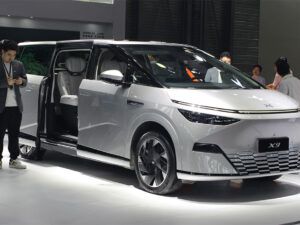- Xpeng's in-house developed autonomous driving chip will will first be used in one of its new models, according to local media.
- The chip is 20 percent more utilized than general-purpose automotive chips and can handle large models with up to 30 billion parameters.

Xpeng's (NYSE: XPEV) in-house developed autonomous driving chip, Turing, will be officially mass-produced in the second quarter, and will first be used in one of the electric vehicle (EV) maker's new models, according to a report in local media outlet 36kr yesterday.
The chip integrates two neural network processing brains that the company has developed in-house with specific architectural processing for neural networks, the report said, citing an insider.
The chip offers a 20 percent increase in utilization over general-purpose automotive chips with high computing power and can handle large models with up to 30 billion parameters, the person said.
The 30 billion parameter support is high, the report noted, adding that for comparison, Li Auto (NASDAQ: LI) currently has a VLA (Visual-Language-Action) parameter count of about 2.2 billion.
However, larger model parameter counts also tend to be accompanied by higher latency issues for inference, which the company has yet to reveal how it will address, the report said.
Xpeng announced on August 28, 2024 at the launch of its new model, the Mona M03, that its first AI chip, Turing, saw a successful tape-out on August 23.
Tape-out is a technical term used in the field of integrated circuit design to refer to the process of converting a circuit design into a chip that can be produced on an assembly line after the chip design has been completed.
After successful tape-out, the chip prototype can begin mass production if it passes subsequent testing.
Turing chips will be used in Xpeng's EVs, robots, and flying cars, the company's chairman and CEO He Xiaopeng said at the time.
The chip is a central computing architecture chip that supports driving smart cockpits and smart driving, and the AI arithmetic is at the level of three Orin X chips, Mr. He said at the time.
The Turing chip's computing power is around 700 TOPS, close to Nvidia's latest Thor, 36kr's report yesterday noted.
Nvidia unveiled its Drive Thor SoC for autonomous driving back on September 20, 2022, as a successor to Drive Orin, targeting automakers' 2025 models.
Thor was initially designed for 2,000 TOPS of computing power and was originally scheduled for mass production in mid-2024.
However, the chip has encountered challenges in mass production, with Nvidia currently offering what is essentially a version with a computing power of 750 TOPS, according to 36kr.
There are still flaws in both the hardware and software of the Thor chip, and now Nvidia is not even promising computing power anymore, the report said, citing an industry source.
Automakers that previously announced they would adopt Thor chips, such as BYD (HKG: 1211, OTCMKTS: BYDDY), Zeekr (NYSE: ZK), Li Auto, and Xpeng, may be affected in some way, the report noted.
In a way, in-house developed chips can help car companies speed up the rollout of new models, the report noted.
Nio's (NYSE: NIO) in-house developed five nm process-based Shenji NX9031 autonomous driving chip is already in mass production, and deliveries of the first model with the chip, the ET9, began late last month.
Nio has not announced the exact computing power of the Shenji NX9031 chip, but previously said it was equivalent to four mainstream smart driving chips. It uses two Shenji NX9031 chips in the ET9.
In a live video broadcast in February, William Li, Nio's founder, chairman, and CEO, said that the company's main-selling models -- the ET5, ET5 Touring, ES6, and EC6 -- would have facelifts that would use Nio's in-house developed Shenji autonomous driving chip.
Yesterday, rumors surfaced that Nio's updated ES6 SUV and EC6 coupe SUV are expected to hit the market in May, and the updated ET5 sedan and ET5 Touring shooting brake are expected to go on sale in June.
Currently, Nio's main brand models come standard with four Nvidia Orin chips, and the total computing power of its smart driving system is 1,016 TOPS. The first model of its sub-brand Onvo, the L60, uses one Nvidia Orin X chip with 254 TOPS.
Li Auto's in-house developed autonomous driving chip is also close to taping out, and if it goes well, it could also lean more vehicle resources towards its in-house developed chip, the latest 36kr report said.








